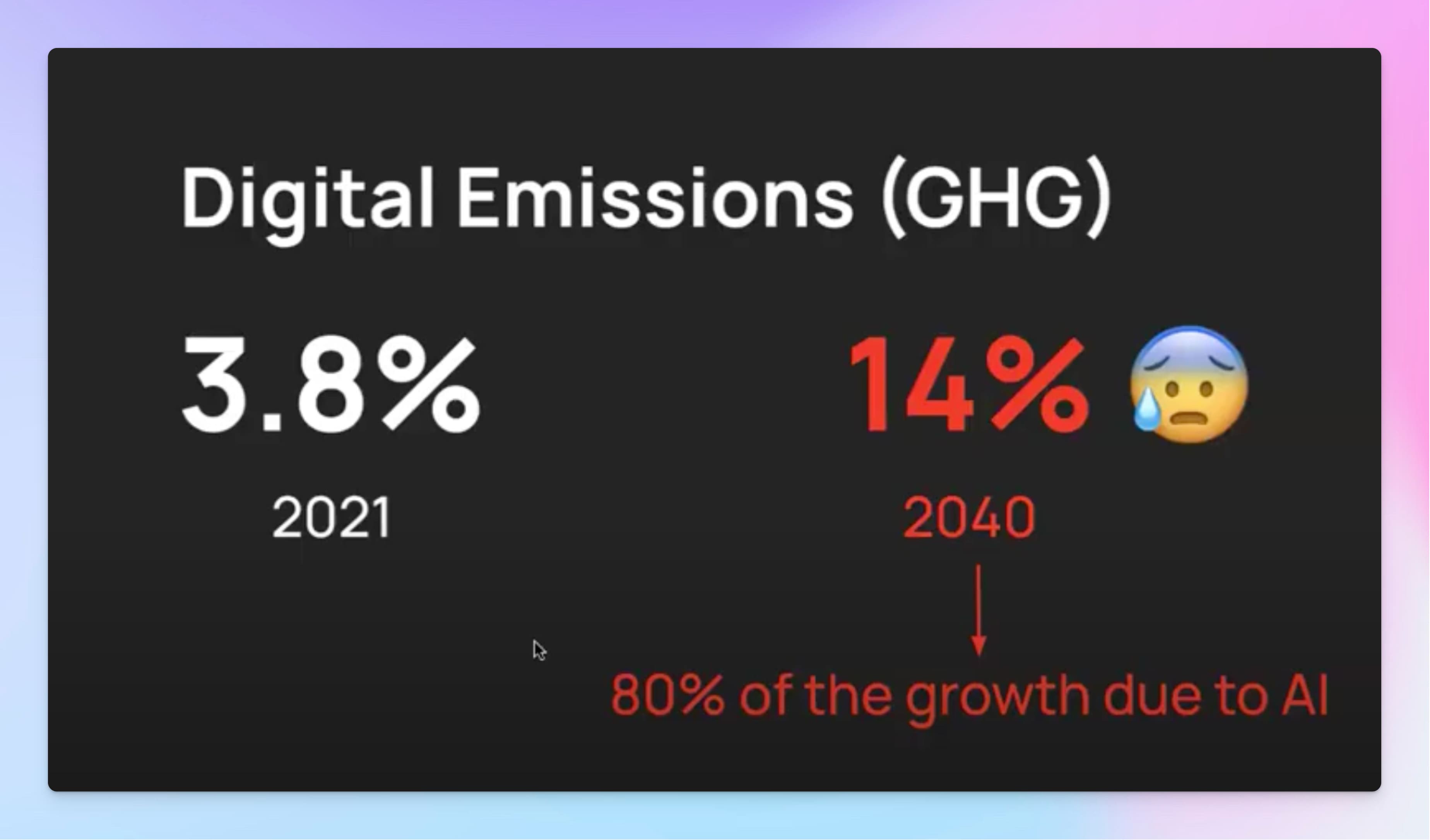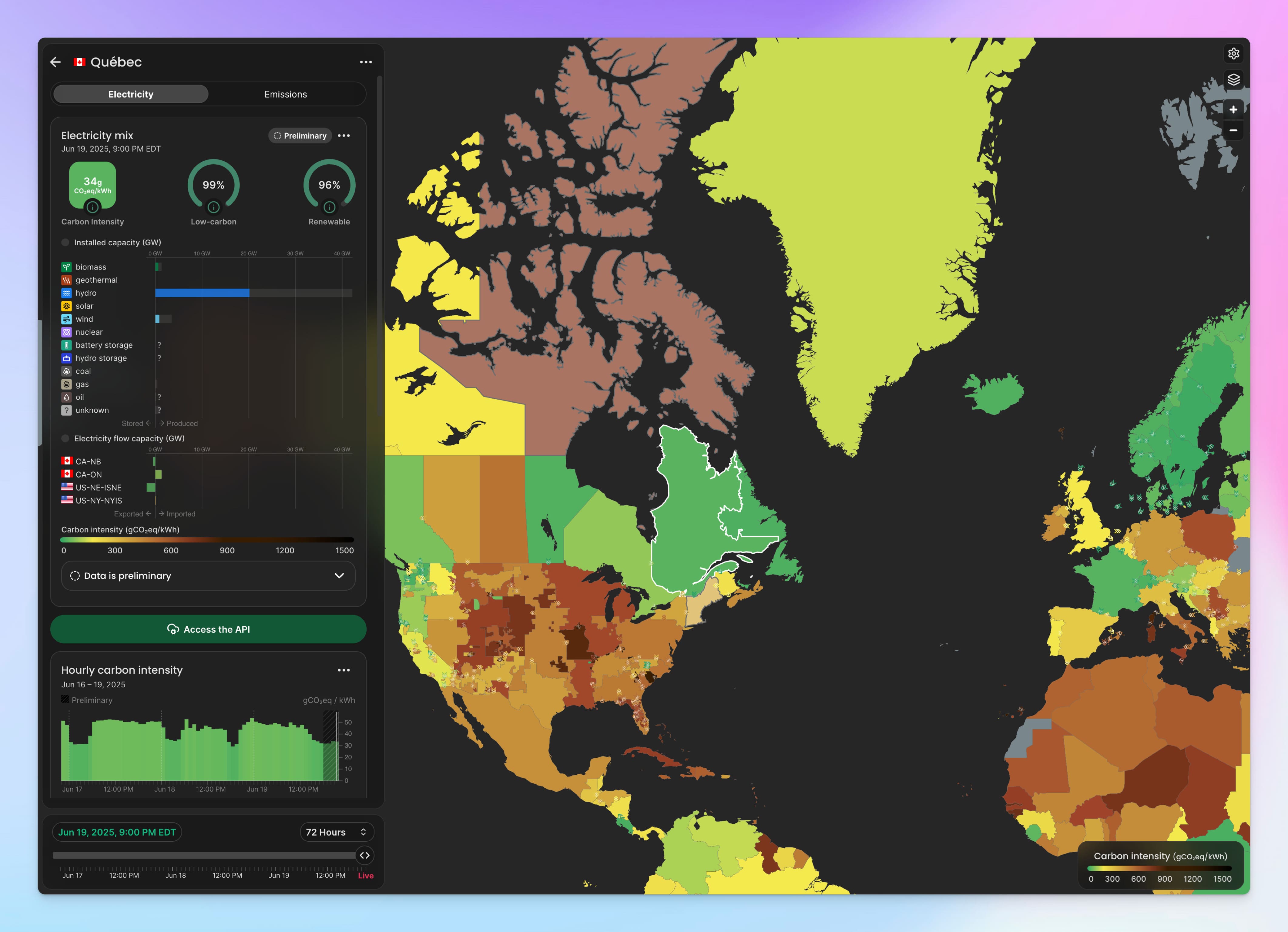An explainer on the hidden toll of cloud computing—a Terra.do Expert Event Recap
When we think of "the cloud," we often picture fluffy white formations against a pristine blue sky, a seemingly clean, ethereal concept that perfectly embodies our digital age. But as Pascal Joly, product lead and AI data solutions expert, revealed during a recent Greening the Cloud event, the reality behind our cloud-based digital infrastructure is starkly different from this idyllic imagery.
With 25 years of experience in IT services and as the founder of IT Climate Ed, Pascal guided our audience through an eye-opening exploration of cloud computing's environmental impact. What emerged was a sobering picture of an industry at a critical crossroads, where rapid technological advancement and environmental responsibility must find common ground.
The Scale of the Challenge
The numbers Pascal shared paint a compelling picture of our digital future. In 2021, digital emissions accounted for approximately 3.8% of global greenhouse gas emissions. But here's where it gets concerning: projections suggest this could reach 14% by 2040, driven primarily by the explosive growth of artificial intelligence and cloud services.
To put this in perspective, Pascal noted that 4% was roughly equivalent to the aviation industry's carbon footprint. At 14%, we're talking about industrial-level emissions from what many still perceive as "clean" technology.
"If you follow the path to carbon emission," Pascal explained, "you start with a cloud service, let's say a conversation with ChatGPT, which is hosted on servers running in data centers. These data centers are powered by electricity that's still about 80% sourced from fossil fuels."
But the story doesn't begin or end with electricity consumption. The lifecycle of cloud infrastructure reveals a complex web of environmental impacts that most users never consider.
The Hidden Infrastructure Behind the Cloud
One of the most striking revelations from Pascal's presentation was the sheer scale of resource extraction required for cloud infrastructure. To obtain just 200 grams of tantalum, a mineral essential for capacitors in virtually all servers, manufacturers must extract and mine one ton of ore. This isn't just about energy; it's about fundamentally reshaping landscapes and ecosystems.
The rare earth minerals that power our digital infrastructure present their own challenges. Despite their name, these minerals aren't particularly rare, but they're dispersed and expensive to extract. China controls about 60% of global supplies, creating both geopolitical and environmental concerns. The extraction process requires enormous amounts of water, which becomes contaminated with radioactive materials and heavy metals, often affecting groundwater in already water-stressed regions.
"When you look at pictures of these mines," Pascal shared, displaying images of massive extraction sites, "you realize the scale of environmental disruption required to support our digital lives."
The operational requirements are equally staggering. Data centers consume 4-6% of global electricity production, and this consumption is highly concentrated in a few countries. Meanwhile, cooling these massive facilities requires millions of gallons of water annually, even with the most efficient systems achieving only about 10% overhead, meaning 10% of a data center's total power consumption goes purely to cooling.

Measuring What Matters: The Carbon Accounting Challenge
During our discussion, several community members raised important questions about measurement and transparency. Pascal walked us through the greenhouse gas protocol framework, explaining how cloud emissions fall into three categories:
Scope 1: Direct emissions from data center operations
Scope 2: Emissions from electricity consumption
Scope 3: Upstream and downstream activities, including hardware manufacturing and end-of-life disposal
The challenge, as Pascal revealed, is that cloud providers aren't equal in their reporting transparency. In his assessment, Google Cloud ranks first in providing comprehensive emissions data across all three scopes, Microsoft comes second, and Amazon Web Services (AWS) lags significantly behind, still not providing Scope 3 emissions data.
"This means AWS customers essentially need to hire consultants to understand their true carbon footprint," Pascal noted, highlighting a significant gap for millions of businesses relying on the world's largest cloud provider.
Johnny from our community raised a particularly insightful question about granular emissions calculation: "How do cloud providers really calculate emissions when user workloads are distributed across various servers and geographies?"
Pascal's response highlighted a critical issue: there's no standard requiring cloud providers to report customer emissions consistently. Each provider uses different methodologies and assumptions, often without full transparency about their calculations.
Tools and Solutions: A Growing Ecosystem
Despite these challenges, Pascal introduced us to a growing ecosystem of tools designed to help organizations measure and manage their cloud carbon footprint. Electricity Maps emerged as a particularly powerful platform, providing real-time data on the carbon intensity of regional electricity grids worldwide.
"If you look at Quebec, you'll see it's very green because it's mostly powered by hydro," Pascal explained, walking us through the platform's color-coded global map. "But if you look at Eastern Europe or the middle of the US, where we have high concentrations of data centers, you'll see much darker colors indicating coal and gas power."

For developers, tools like CodeCarbon offer the ability to track emissions directly within code, providing near real-time feedback on the environmental impact of computational tasks. This granular approach enables teams to optimize not just for performance, but for sustainability.
The market for specialized carbon management platforms is also evolving, with companies like Frugilio offering comprehensive IT-specific carbon accounting that goes beyond operational emissions to include embodied emissions from hardware manufacturing and end-of-life impacts.
Sustainable Cloud Architecture: Practical Strategies
When Anurag from our community asked about developing skills at the intersection of cloud, DevOps, and climate tech, Pascal emphasized an important point: "Any job can be a climate job. It's not just because you don't have sustainability in your title that you can't work on sustainability."
Pascal outlined practical strategies for different roles within organizations:
Cloud Architects can focus on three key principles:
Data optimization: Minimizing storage and transfer through compression, deduplication, and intelligent caching
Density: Maximizing hardware utilization through containerization and virtualization
Elasticity: Dynamically scaling resources based on actual demand
Development and QA teams can implement green software practices, including emission tracking within code, resource-efficient algorithms, and ephemeral infrastructure that automatically shuts down unused resources.
IT Operations teams play a crucial role in selecting cloud regions with lower carbon intensity, using tools like Electricity Maps to make informed decisions about workload placement.
The Business Case for Sustainability
Charles from our community asked a crucial question: "Which actions are most impactful for actually reducing emissions?"
Pascal's answer was methodical: "Start with measurement. Create a baseline, identify your highest emitters, then look for low-hanging fruit where you can achieve maximum benefit without completely rebuilding your applications."
But the business case extends beyond pure environmental impact. As Pascal noted, organizations are increasingly facing sustainability requirements in RFPs and contract renewals. Customers are becoming more conscious about the environmental footprint of the services they purchase. Additionally, regulatory frameworks are evolving rapidly, particularly in Europe, with similar trends emerging in Asia Pacific and various US states.
The Renewable Energy Challenge
During our Q&A session, Draco raised an important question about obstacles preventing data centers from switching to renewable energy. Pascal's response revealed the complexity of achieving truly clean cloud computing.
While major cloud providers have made significant investments in renewable energy through power purchase agreements (PPAs), the challenge lies in achieving 24/7 clean energy at specific locations. "Until recently, cloud providers used an accounting trick where they could claim clean emissions by offsetting with renewable energy purchases in completely different regions," Pascal explained.
The newer push for location-based, continuous clean energy is much more challenging. It requires battery storage for intermittent renewables or access to always-available clean sources like hydro or nuclear power, resources that are in limited supply and face competition from homes, industry, and electric vehicles.
Water: The Overlooked Resource
Charles raised another critical point about water usage in data centers, questioning whether the issue might be exaggerated given advances in closed-loop cooling systems. Pascal's response was unequivocal: "It's not exaggerated at all. Completely closed-loop systems don't exist today."
Even the most efficient data centers achieve only about 10% overhead for cooling, but when you're talking about a 100-megawatt facility, that's still 10 megawatts dedicated purely to cooling and millions of gallons of water consumption. Despite recycling efforts, losses from evaporation and contamination are inevitable.
The AI Acceleration Factor
Throughout our discussion, the impact of artificial intelligence loomed large. As Shri asked toward the end of our session, "AI is growing so rapidly, is this problem getting exponentially worse?"
Pascal's response was sobering: "If we don't do anything and keep business as usual, this problem will become exponentially worse. That's why bringing awareness from the bottom up and getting more people involved in understanding mitigation strategies is crucial right now. We're at a pivot point."
The growth isn't slowing down either. Just days before our session, Amazon announced a $20 billion investment in US data centers, with some facilities planned to be powered primarily by natural gas highlighting the ongoing challenge of scaling infrastructure while maintaining environmental commitments.
Education and Action: The Path Forward
When Marie asked whether a technical background was necessary for Pascal's upcoming Terra.do course on Sustainable Cloud Engineering, his response emphasized accessibility: "You don't need to be very technical. General knowledge about cloud computing terminology will help you get started and derive maximum value from the course."
This democratization of knowledge reflects a broader theme from our discussion: sustainability in cloud computing isn't just a technical challenge…it's a cultural and educational one. As Pascal noted, "Many of you might not be cloud architects, but understanding these principles helps you contribute to sustainability regardless of your specific role."
The self-paced course Pascal developed for Terra.do includes weekly office hours, and certification, designed to bridge the gap between technical knowledge and environmental impact. It's part of a growing ecosystem of educational resources helping professionals at all levels contribute to more sustainable digital practices.
Looking Ahead: A Critical Juncture
Our session concluded with a sense of both urgency and opportunity. The statistics are daunting: digital emissions potentially reaching 14% of global totals by 2040, massive resource extraction requirements, ongoing water consumption challenges, and the acceleration of AI driving even greater infrastructure demands.
Yet the tools, knowledge, and frameworks for addressing these challenges are rapidly evolving. From granular emissions tracking to renewable energy procurement strategies, from architectural best practices to regulatory frameworks, the pieces for a more sustainable digital future are coming together.
As Pascal emphasized, we're at a pivot point. The decisions made today about cloud architecture, energy procurement, and operational practices will determine whether the digital revolution becomes a climate catastrophe or a catalyst for efficient, sustainable innovation.
The cloud may not be as clean as its marketing imagery suggests, but with awareness, measurement, and action, we can work toward making it truly deserving of its ethereal name. The question isn't whether we can afford to make cloud computing sustainable…it's whether we can afford not to.
What Next?
Watch the live event's recording: Greening the Cloud: Engineering for a Sustainable Digital Future.
Pascal's course on Sustainable Cloud Engineering offers practical skills for professionals looking to integrate sustainability into their cloud and AI work. For more in-depth conversations and events, check out what's coming up next on Terra.do events.
Special thanks to all our community members who participated in this session, particularly those who asked questions that helped deepen our collective understanding of this critical topic.


